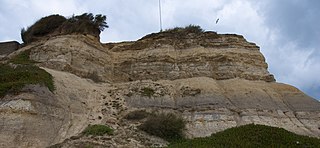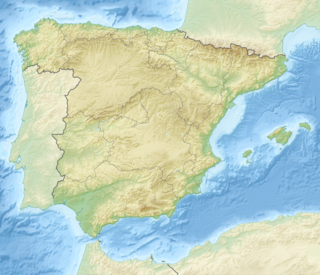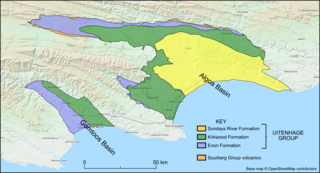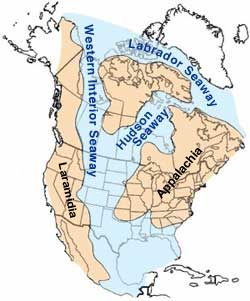Related Research Articles

Iguanodon, named in 1825, is a genus of ornithopod dinosaur that existed roughly halfway between the first of the swift bipedal hypsilophodontids of the mid-Jurassic and the duck-billed dinosaurs of the late Cretaceous. While many species have been classified in the genus Iguanodon, dating from the late Jurassic Period to the early Cretaceous Period of Asia, Europe, and North America, taxonomic revision in the early 21st century has defined Iguanodon to be based on one well-substantiated species: I. bernissartensis, which lived from the late Barremian to the earliest Aptian ages in Belgium, Spain, Germany, England, Portugal and possibly elsewhere in Europe, between about 126 and 122 million years ago. Iguanodon were large, bulky herbivores. Distinctive features include large thumb spikes, which were possibly used for defense against predators, combined with long prehensile fifth fingers able to forage for food.

The Lance (Creek) Formation is a division of Late Cretaceous rocks in the western United States. Named after Lance Creek, Wyoming, the microvertebrate fossils and dinosaurs represent important components of the latest Mesozoic vertebrate faunas. The Lance Formation is Late Maastrichtian in age, and shares much fauna with the Hell Creek Formation of Montana and North Dakota, the Frenchman Formation of southwest Saskatchewan, and the lower part of the Scollard Formation of Alberta.

The Wealden Group, occasionally also referred to as the Wealden Supergroup, is a group in the lithostratigraphy of southern England. The Wealden group consists of paralic to continental (freshwater) facies sedimentary rocks of Berriasian to Aptian age and thus forms part of the English Lower Cretaceous. It is composed of alternating sands and clays. The sandy units were deposited in a flood plain of braided rivers, the clays mostly in a lagoonal coastal plain.

The Scollard Formation is an Upper Cretaceous to lower Palaeocene stratigraphic unit of the Western Canada Sedimentary Basin in southwestern Alberta. Its deposition spanned the time interval from latest Cretaceous to early Paleocene, and it includes sediments that were deposited before, during, and after the Cretaceous-Paleogene (K-Pg) extinction event. It is significant for its fossil record, and it includes the economically important coal deposits of the Ardley coal zone.

The Cedar Mountain Formation is the name given to a distinctive sedimentary geologic formation in eastern Utah. The formation was named for Cedar Mountain in northern Emery County, Utah, where William Lee Stokes first studied the exposures in 1944.

The Cloverly Formation is a geological formation of Early Cretaceous age that is present in parts of Montana, Wyoming, Colorado and Utah in the western United States. It was named for a post office on the eastern side of the Bighorn Basin in Wyoming by N.H. Darton in 1904. The sedimentary rocks of formation were deposited in floodplain environments and contain vertebrate fossils, including a diverse assemblage of dinosaur remains. In 1973, the Cloverly Formation Site was designated as a National Natural Landmark by the National Park Service.

The Bearpaw Formation, also called the Bearpaw Shale, is a geologic formation of Late Cretaceous (Campanian) age. It outcrops in the U.S. state of Montana, as well as the Canadian provinces of Alberta and Saskatchewan, and was named for the Bear Paw Mountains in Montana. It includes a wide range of marine fossils, as well as the remains of a few dinosaurs. It is known for its fossil ammonites, some of which are mined in Alberta to produce the organic gemstone ammolite.

Dakotadon is a genus of iguanodont dinosaur from the Barremian-age Lower Cretaceous Lakota Formation of South Dakota, USA, known from a partial skull. It was first described in 1989 as Iguanodon lakotaensis, by David B. Weishampel and Philip R. Bjork. Its assignment has been controversial. Some researchers suggest that "I." lakotaensis was more basal than I. bernissartensis, and related to Theiophytalia, but David Norman has suggested that it was a synonym of I. bernissartensis. Gregory S. Paul, working on a revision of iguanodont species, gave "I." lakotaensis its own genus (Dakotadon) in 2008.

The El Castellar Formation is a geological formation in La Rioja and Teruel, Spain whose strata date back to the possibly the Valanginian to the Barremian stages of the Early Cretaceous. Dinosaur remains are among the fossils that have been recovered from the formation.

The Kirkwood Formation is a geological formation found in the Eastern and Western Cape provinces in South Africa. It is one of the four formations found within the Uitenhage Group of the Algoa Basin – its type locality – and in the neighbouring Gamtoos Basin. Outcrops of the Kirkwood are also found along the Worcester-Pletmos, Herbertsdale-Riversdale, Heidelberg-Mossel Bay, and Oudtshoorn-Gamtoos basin lines. At these basins the Kirkwood Formation underlies the Buffelskloof Formation and not the Sundays River Formation.
The Wapiti Formation is a geological formation of the Western Canada Sedimentary Basin in northwestern Alberta, and Northeastern British Columbia, Canada. Its deposition spanned the time interval from Late Cretaceous to early Paleocene, and it includes sediments that were deposited before, during, and after the Cretaceous-Paleogene (K-Pg) extinction event. It was named by G.M. Dawson in 1881, presumably for exposures along the lower part of the Wapiti River and downstream along the Smoky River in Alberta.

The Aguja Formation is a geological formation in North America, exposed in Texas, United States and Chihuahua and Coahuila in Mexico, whose strata date back to the Late Cretaceous. Dinosaur remains are among the fossils that have been recovered from the formation.

The Prince Creek Formation is a geological formation in Alaska with strata from the early Campanian stage of the Upper Cretaceous to the Danian of the Paleocene, between 80 and 62 million years ago. Dinosaur remains are among the fossils that have been recovered from the formation.
This is an overview of the fossil flora and fauna of the Maastrichtian-Danian Hell Creek Formation.

The Williams Fork Formation is a Campanian (Edmontonian) geologic formation of the Mesaverde Group in Colorado. Dinosaur remains are among the fossils, most notably Pentaceratops sternbergii, that have been recovered from the formation, although none have yet been referred to a specific genus. Other fossils found in the formation are ammonites, Neosuchia, and the mammal Meniscoessus collomensis.
The Bissett Formation is a Mesozoic geologic formation. Dinosaur remains diagnostic to the genus level are among the fossils that have been recovered from the formation.

During most of the Late Cretaceous the eastern half of North America formed Appalachia, an island land mass separated from Laramidia to the west by the Western Interior Seaway. This seaway had split North America into two massive landmasses due to a multitude of factors such as tectonism and sea-level fluctuations for nearly 40 million years. The seaway eventually expanded, divided across the Dakotas, and by the end of the Cretaceous, it retreated towards the Gulf of Mexico and the Hudson Bay. This left the island masses joined in the continent of North America as the Rocky Mountains rose. From the Cenomanian to the end of the Campanian ages of the Late Cretaceous, Appalachia was separated from the rest of North America. As the Western Interior Seaway retreated in the Maastrichtian, Laramidia and Appalachia eventually connected. Because of this, its fauna was isolated, and developed very differently from the tyrannosaur, ceratopsian, hadrosaurid, pachycephalosaur and ankylosaurid dominated fauna of the western part of North America, known as "Laramidia".

The prehistory of the United States comprises the occurrences within regions now part of the United States of America during the interval of time spanning from the formation of the Earth to the documentation of local history in written form. At the start of the Paleozoic era, what is now "North" America was actually in the southern hemisphere. Marine life flourished in the country's many seas, although terrestrial life had not yet evolved. During the latter part of the Paleozoic, seas were largely replaced by swamps home to amphibians and early reptiles. When the continents had assembled into Pangaea drier conditions prevailed. The evolutionary precursors to mammals dominated the country until a mass extinction event ended their reign.

The Brule Formation was deposited between 33 and 30 million years ago, roughly the Rupelian age (Oligocene). It occurs as a subunit of the White River Formation in Nebraska, Colorado, North Dakota, South Dakota, and Wyoming.
References
- 1 2 SDSM&T 1998-99 Undergraduate and Graduate Catalog (PDF). South Dakota: South Dakota School of Mines and Technology. 1998. p. 316. Retrieved 2009-11-24.
- 1 2 Macdonald, J. R.; Minkler, Heidi; Martin, James. "Museum of Geology History". South Dakota Museum of Geology. Retrieved 24 November 2009.
- ↑ Bowman, John Stewart (1986). The World Almanac of the American West. New York, NY: Ballantine Books. p. 355. ISBN 0-345-33720-4.
- ↑ Bjork, Philip R. (September 1975). "Observations on Proscalops tertius (Mammalia: Insectivora) of the Upper Oligocene of South Dakota". Journal of Paleontology . SEPM Society for Sedimentary Geology. 49: 808–813. ISSN 0022-3360. JSTOR 1303274.
- ↑ "Dinosaur Remains Found in S. Dakota". San Jose Mercury News . August 30, 1985. pp. 13A. Retrieved 24 November 2009.
- ↑ Weishampel, David B.; Bjork, Philip R. (March 30, 1989). "The First Indisputable Remains of Iguanodon (Ornithischia: Ornithopoda) from North America: Iguanodon lakotaensis, sp. nov". Journal of Vertebrate Paleontology . Society of Vertebrate Paleontology. 9 (1): 56–66. doi:10.1080/02724634.1989.10011738. ISSN 0272-4634. JSTOR 4523237.
- ↑ Weishampel, David B.; Osmólska, Halszka; Dodson, Peter (2004). The Dinosauria. Berkeley: University of California Press. p. 416. ISBN 978-0-520-24209-8 . Retrieved 2009-11-24.
- ↑ Tanke, Darren H.; Carpenter, Kenneth; Skrepnick, Michael William (2001). Mesozoic Vertebrate Life. Bloomington: Indiana University Press. p. 185. ISBN 978-0-253-33907-2 . Retrieved 2009-11-24.